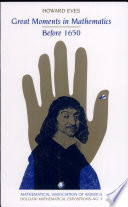 | Edward Brooks - Geometry, Modern - 1901 - 278 pages
...DF=EC. ButAEDFis&CJ, and DF—AE; hence EC = AE, or AC is bisected at E. COR. — The line which joins the middle points of two sides of a triangle is parallel to the third side, and equal to half of it. For, in the same figure, the line through D \\ to AB passes through E (Th.... | |
 | Eldred John Brooksmith - Mathematics - 1901 - 368 pages
...follow the >•* term ("the remainder after r terms") is less than - ur. \~qx 3. Prove that the straight line joining the middle points of two sides of a triangle is parallel to, and is equal to half the length of the third side. If ABCD be any four.sided figure the three straight... | |
 | Arthur Schultze, Frank Louis Sevenoak - Geometry - 1901 - 396 pages
...bisects the other non-parallel side. PROPOSITION XXXIX. THEOREM 147. A. line which joins the midpoints of two sides of a triangle is parallel to the third side and equal to half of it. \ Hyp. In A ABC: AD = DB, AE = EC.. To prove 1°. DE II BC. 2°. DE = iBC.... | |
 | Arthur Schultze - 1901 - 260 pages
...bisects the other non-parallel side. PROPOSITION XXXIX. THEOREM 147. A line which joins the midpoints of two sides of a triangle is parallel to the third side and equal to half of it. B a Hyp. In A ABC: AD = DB, AE = EC. To prove 1°. DE II BC. 2°. DE = \BC.... | |
 | Thomas Franklin Holgate - Geometry - 1901 - 462 pages
...angles of a triangle is equal to two right angles. § 101. (15) The line-segment joining the mid-points of two sides of a triangle is parallel to the third side and equal to half of it. § 130. (16) If from the mid-point of one side of a triangle there is drawn... | |
 | Arthur Schultze - 1901 - 392 pages
...bisects the other non-parallel side. PROPOSITION XXXIX. THEOREM 147. A line which joins the midpoints of two sides of a triangle is parallel to the third side and equal to half of it. BC Hyp. In A ABC: AD = DB, AE = EC. To prove 1°. DE II BC. 2°. DE = \BC.... | |
 | Edinburgh Mathematical Society - Electronic journals - 1901 - 232 pages
...conjugate of a side of a triangle is any straight line through the opposite vertex, and that the straight line joining the middle points of two sides of a triangle is its own isotomic conjugate. I have traced the curve for a position of the given point in each of the... | |
 | Linda Bostock, Suzanne Chandler, F. S. Chandler - Juvenile Nonfiction - 1979 - 660 pages
...In Questions 1—8 give proofs based on vector methods. 1) Prove that the line joining the midpoints of two sides of a triangle is parallel to the third side and equal to half of it. 2) Prove that the internal bisectors of the angles of a triangle are concurrent.... | |
 | Howard Whitley Eves - History - 1983 - 292 pages
...FM, EN. Then FE is parallel to BC and equal to one-half of BC (the line segment joining the midpoints of two sides of a triangle is parallel to the third side and is equal to one-half the third side). Similarly, MN is parallel to BC and is equal to one-half... | |
 | G.E. Martin - Mathematics - 1997 - 536 pages
...quadrilaterals in absolute geometry are contained in Theorem 22.4. • 22.16 The line through the midpoints of two sides of a triangle is parallel to the third side. 22.17 Theorem 22.17 could have followed Definition 21.9. Why didn't it? Would this rearrangement have... | |
| |